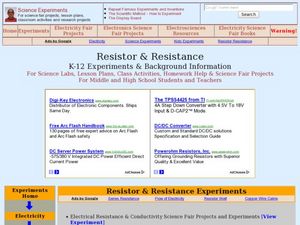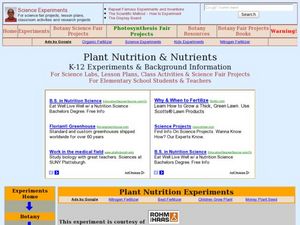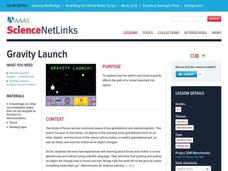Curated OER
Cosmetic Products Evaluation
Students evaluate different cosmetic products. For this chemistry lesson, students determine the physical and chemical components of their samples. They perform various test such as pH, viscosity, conductivity and formulate a conclusion...
Curated OER
Inter-State Matters
Students explore the six phase transitions between gases, liquids and solids for a variety of elements. Each group of students focuses on a different element, investigating its physical properties during each of the six phase transitions.
Curated OER
Understanding: Uncertainty
Students discuss the Heisenberg uncertainty principle and how it applies to the subatomic world. Working in groups, they design a model that would help others to understand the uncertainty principle. Written explanations are included...
Curated OER
Battery Charger
Students explain how battery chargers work. In this physics lesson, students discuss the two main ways that vehicles get charged. They build their own battery charger.
Curated OER
Lenz's Law
Students conduct a series of experiments on electromagnetic induction. In this physics lesson, students apply the right hand rule to determine the current direction and electromotive force. They test Lenz's and Faraday's law by observing...
Curated OER
Resistor and Resistance
High schoolers explore electrical resistance through various experiments. For this physics lesson, students calculate resistance using a mathematical formula. They explain how colors identify the resistance value of a resistor.
Curated OER
Swings
Students investigate variables which may seem to affect the movement of a pendulum, or "swing."They interpret their observations and apply the scientific principles to develop explanations and solve a new problem.
Curated OER
Types And Magnitudes Of Earthquakes
Students investigate the concept of earthquakes and the different types of magnitudes. They research the Richter scale and how it is used to measure the intensities of earthquakes. Students then apply the concept by completing a...
Curated OER
Concrete Research
Students explore concrete. In this physical science and computer research instructional activity, students work in groups to answer specific questions about concrete. Each group of students completes a different worksheet with a...
Curated OER
Mixed Review-Chemistry
In this chemistry review activity, students answer a variety of questions about matter, elements, the kinetic theory, chemical and physical properties and the distillation process. They complete a concept map about matter.
Curated OER
Density Challenge
Students calculate the densities of several liquids that appear similar. In this physical science lesson, students go beyond understanding the way liquids of different densities behave to researching how this knowledge applies in real...
Curated OER
Rocks and Minerals
Students are able to describe earth processes (e.g., rusting, weathering, erosion) that have affected selected physical features in students, neighborhoods. They are able to identify various earth structures (e.g., mountains, faults,...
Curated OER
Sounds Good to Me
Students determine density and hardness of wood samples based on several investigations. In this physical science and music lesson, students visit four centers and perform tests on wood samples to determine densities and hardnesses. They...
Curated OER
Plant Nutrition and Nutrients
Students observe seeds growth and examine the different parts of the seedling. In this biology lesson, students compare the growth of seeds planted in soil and in hydroponics. They record their observations in their science journal and...
Curated OER
Internet Field Trip: Simple Machines
Students research simple machines. In this physics lesson, students participate in a WebQuest to gain knowledge about simple machines. WebQuest activities and worksheets are included in this lesson.
Curated OER
Scenario challenge
Fifth graders become familiar with the geography of New Hampshire and the importance of specific sites in history. In this New Hampshire lesson, 5th graders create a brochure including points of interest and showing distances between...
Curated OER
Gravity Launch
Students examine how gravity affects launching rockets into space. In this physical science lesson, students review the concept of gravity and use an interactive online site, "Gravity Launch," to simulate a rocket launch.
Curated OER
No Bones About It
Students act as paleontologists, examining pictures of dinosaur skeletons and applying their knowledge of the relationship between skeletal features and survival, to create 'Paleontology Reports' about their perceptions of the lives of...
Curated OER
How a Liquid Changes to a Gas
Second graders identify three forms of matter- solids, liquids, and gases with 100% accuracy. They observe water evaporating from an open container and water evaporating and condensing in a closed container. The students assess that a...
Curated OER
Who Did It?
Students explore how forensic science is used in criminal investigations. They learn that for the next few days that are going to try to solve a crime that took place in the classroom. Students are given a story to read about the crime...
Curated OER
Inclined Plane and Pulley
Learners describe how inclined plane and pulleys make work easier. In this physics lesson, students calculate work done and mechanical advantage of both simple machines. They collect data from the experiment and construct graphs.
Curated OER
Magnetorheological Fluids
Students conduct a series of experiments on magnetorheological fluids. In this physics lesson, students explain how these fluids behave in varying magnetic field strength. They give practical applications of magnetorheological fluids.
Curated OER
Sand or Rock? Finding Out From 1,000 km
Young scholars observe how measurements are made with different instruments. In this remote sensing activity students investigate the physical state of surfaces including the surfaces of the solar system.
Curated OER
Simple Machine Research
Fifth graders demonstrate the ability to use scientific skills and Processes to describe forces that act upon objects to cause specific changes in motion. They identify and describe a science problem related to forces and simple machines.

























